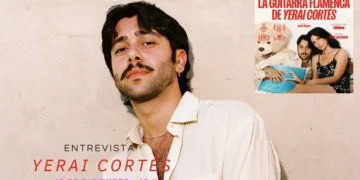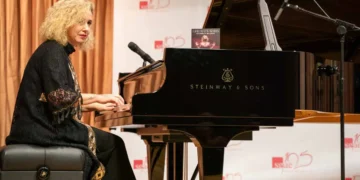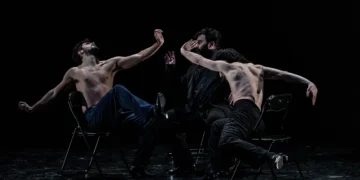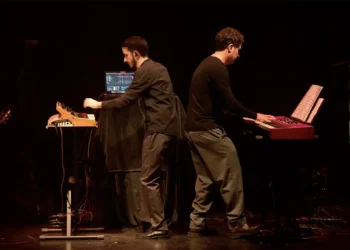|
||
|
Cante: Bernarda de Utrera, Inés de Utrera, Miguel |
No one need wonder what the surname is…Jiménez
Peña, of Utrera, sister of Fernanda and flamenco singer with
an unmistakable Utrera style of singing. “Su gente”
(her people) were those of her family and town, and from Lebrija,
the people who have always shared her flamenco and personal experiences,
even since before the two young sisters first appeared in the film
“Duente y Misterio del Flamenco” a half century ago.

flamenco is currently enjoying a worldwide boom which is growing
exponentially and shows no signs of letting up, it’s been
some time since we’ve heard from this flamenco town par excellence.
Why does it seem that the world is getting bigger while Utrera sings
and breathes and unfolds in get-togethers and family fiestas where
cante is not a product but a fundamental part of life? Why do we
continue to dream that “cualquier diíta menos pensao”
(‘any day now’, from a famous verse of soleá)
our beloved Fernanda will once again sing?
These are the questions that were hanging in the air the night
of February 17th when doña Bernarda and her people appeared
on stage without fanfare, artistic airs or fancy wardrobe, with
all the naturalness of a group of friends and family coming together
to have a good time. The intent is admirable, no question about
it. These days we are force-fed and saturated with lavishly funded
grand theatrical works, press conferences and producers. “Be
careful what you wish for because it might come true” instructs
the old line. For years we flamenco-lovers bemoaned and condemned
the lack of world recognition, of economic support and of a dignified
place within the world of music. Now the universal nature of flamenco
is becoming a reality, but the most legitimate representatives of
the art that triggered this revolution, the ‘guardians’
if you will, are where they have always been, at the bottom of the
food chain.
But the performers must assume some of the blame. The stage of Seville’s
Teatro Central is not a gypsy baptism, not matter how determined
the artists are to communicate that experience which they know and
love so well, and it is with deep regret we report that the show
came across as disorganized, in a way that was on the one hand endearing
and sincere, but on the other, theatrically disastrous, with a devil-may-care
attitude that was out of place in this precise venue. The real fiesta
may have taken place after the show, we don’t know, but what
ensued on stage lacked form and inspiration.
 |
|
|
Miguel el Funi,
|
Carmen Ledesma
|
The Utrera addiction to popular songs
‘por bulerías’
Bernarda started out with soleá, a cante she always says
she can’t sing, preferring to leave the honor for her sister,
but moving everyone present with her power and presence all the
same. Then the clear sensitive voice with a fine edge of young Mari
Peña who sang tientos and tangos including those of el Titi
de Triana in the style of Perrate. With attractive contrasts of
cutting highs and lows, and no pyrotechnics, she turned what some
consider a lesser cante into something important, as is customary
in Utrera singers.
Inés de Utrera with her bulerías songs and seductive
stylized voice reveled in the Utrera addiction to popular songs
done ‘por bulerías’. Compás and personality
that ellicted heartfelt ‘oles’ from the audience. Miguel
Funi, a singer and dancer from Lebrija, announced “I’m
going to sing a little siguiriyas to change the mood a bit”.
But siguiriyas when you aren’t in just the right mind-set
is not too easily disguised, and he was unable to find the groove
despite ending with the beautiful “Dices que duermes sola”
verse, and two splendid guitars, those of Antonio Moya and Antonio
Carrasco. Funi is right at home in bulerías and that’s
really all he needs to show his stuff. Sublime elegance in his delightful
minimalist dance, but even so, it didn’t quite come together.

Carmen Ledesma with the cantes of Pinini in the voice of Mari Peña
offered her exquisite, carefully measured dance, but the general
artistic malaise had infected her as well and we began to accept
the disappointment. Bernarda returned with fandango por soleá
which is so cultivated in Utrera…the absolute negation of saccharine
sweetness thanks to Utrera compás and the singer’s
good taste. Without bowing or hardly taking a breath, she asked
for bulería rhythm and delivered a mining cante to fiesta
rhythm, some traditional short styles and pieces of popular song
including her famous ‘María de las Mercedes’
and ‘Callarse por un momento’. All this led to a brief
fiesta finale and frankly, we’ve got no complaints because
we saw some great artists at work. But Utrera’s day is yet
to come.
Ines de Utrera – Bernarda
Texto y fotos: Estela Zatania























